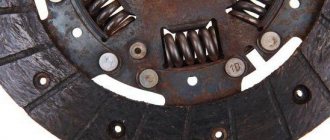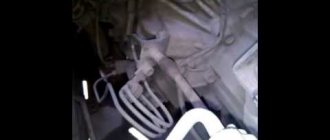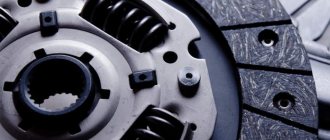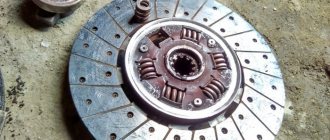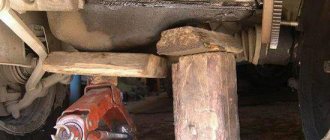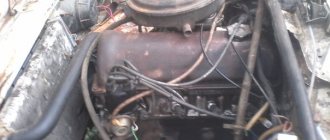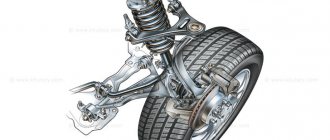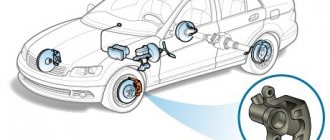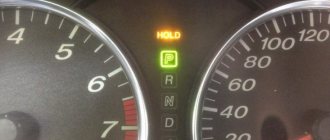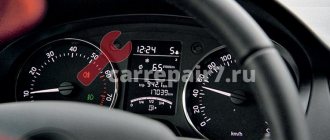Many novice drivers are interested in adjusting the Priora clutch, since problems with the clutch often arise when operating the car. It happens that while driving there are sounds in the form of clicks. These sounds can be removed by adjusting the clutch drive. The article describes in detail the adjustment of the cable and clutch pedal, so even a novice driver can perform these operations.
What should be the free play of the clutch pedal and how to measure it
This concept means the unimpeded movement of the pedal to the actuation point. At first, the leg will not feel any resistance, but after switching on, a certain stiffness will appear. This period of “relaxation” is called free movement.
The average norm is 160 millimeters. The range of acceptable values may vary. For each specific vehicle, technical requirements may vary.
An incorrectly adjusted freewheel can cause serious problems on the road.
Clutch parts will wear out more intensively. Therefore, to prevent unpleasant situations, it is recommended to periodically check the free play.
This should be done using the following algorithm:
- Press the clutch pedal all the way by hand, measure the distance from the floor to its pad using a regular ruler, setting it strictly vertically in relation to the floor surface.
- At the next stage, you need, on the contrary, to press this element back as much as possible and make the same measurements.
- Do simple calculations. Here you just need to subtract the smaller value from the larger number. This will be the amount of free play of the clutch. The norm is 12-14 centimeters. If measurements give readings that fall outside this range, then adequate corrective measures must be taken immediately.
If the value is too high, the disc will be in constant contact with the engine flywheel. Here the clutch will not disengage completely. Under such circumstances, even releasing the pedal smoothly, the driver will not be able to move the car. Operating a car with such a defect will inevitably lead to irreversible consequences and breakdowns.
If the free stroke is small, there will be a loss of torque. Here the car, like an impatient horse, will simply tear off. On some modern cars it is structurally impossible to change the “pickup moment”. In such circumstances, you need to contact the official service.
To adjust the clutch accelerator, you need to set the desired cable length. This is required in cases where the fork free play exceeds 3 millimeters. The adjustment must be carried out using special two nuts, one of which controls the length of the cable, and the other fixes the first one in the selected position. They are placed on the threaded part of the clutch cable.
Why is this necessary - to break the torque transmission from the engine
Everything is very simple. Depending on driving conditions, different torques are supplied to the wheels. Its value can be changed using the gearbox by selecting the desired gear. However, when the gears in the box are in mesh and spinning, it is impossible to change gear. Of course, you can try, but the result will be replacing the destroyed checkpoint. To avoid this in any driving mode, as well as at the beginning of movement, a clutch is used in the car’s design. If you press it, the connection between the gearbox and the engine is broken, as a result of which it becomes possible to calmly change gear or move off.
What are the reasons and what to do if the clutch picks up at the very bottom - at the end of the stroke
During the operation of the car, its components, assemblies and individual parts wear out, which is why some of them are called “consumables”. In the clutch design, the disc friction linings wear out. This leads to an imbalance in the clutch system settings.
Under such circumstances, urgent adjustment of the drive cable is required. The clutch design can be mechanical or hydraulic.
In the first case, each motorist needs to adhere to the following algorithm:
- Open the hood, find the rod to which the cable from the clutch pedal is directly attached.
- Using WD-40 penetrating lubricant, treat the nuts securing the rod, and then loosen them.
- Turn the adjusting nut away from the clutch pedal. This will reduce its free movement.
- At the next stage, you need to make a control measurement of the amplitude of the pedal movement. If the result is positive, all that remains is to tighten the control nut until it stops. If the parameters need correction, then you need to tighten the nut closest to the adjustable pedal until it stops.
After the adjustments have been made, you need to check the operation of the clutch, which, in a good situation, should function without “noise and dust”, and should be easy and pleasant to press.
In this case, the gear shift lever must “stick” precisely and smoothly. The car should not slip or jerk when starting to move. In the case of a hydraulic clutch, the adjustment technology is somewhat different, since such a drive often has an automatic adjustment function. On the other hand, it will not be difficult to adjust it manually if a control nut is provided on the working cylinder pusher.
With the machine raised, adjustments should be made using the following procedure:
- Check the brake fluid level inside the expansion tank.
- Find a pusher on the working cylinder whose function fully corresponds to its name.
- Use pliers to unhook the spring from the clutch fork.
- Move it forward, and then measure the distance between it and the pusher.
- At the next stage, release the plug and then take similar measurements. If the values are outside the recommended range, then direct adjustment must be made.
- Next, press out the spring of the fork and working cylinder.
- Screw the nut towards the working cylinder.
- After taking the appropriate measurements, tighten the control nut. This should be done only when the required parameters have been achieved.
Where should the clutch “grab”?
Where should the clutch “grab”?
Post by hav » July 27, 2012, 21:44
Post by Apolinarii » Jul 27, 2012, 10:35 pm
Post by _Vyacheslav » July 27, 2012, 10:49 pm
Re: where should the clutch engage?
Post by NoiseMouse » July 28, 2012, 01:24
Check the brake fluid level. Perhaps you need to top it up.
I am for peace, love and friendship.
Post by hav » July 28, 2012, 06:23
Post by a3tularu » Jul 28, 2012, 09:20
Post by Michel » Jul 29, 2012, 10:27 pm
And that's true.
Post by Morimoto » Oct 25, 2012 03:15 pm
Recently I began to notice that there was a noticeable jolt when changing gears. This feature arose after driving in deep snow in March and simultaneously operating the clutch pedal (in tension). Mileage 20t.km.
I was thinking about adjusting the clutch pedal. Who regulated? how it's done?
Posted by dogmos » 25 Oct 2012, 15:25
Post by brutalbever » Oct 25, 2012, 04:37 pm
Post by brutalbever » Oct 25, 2012 4:38 pm
Post by alex_xmao » 25 Oct 2012, 16:59
Post by Morimoto » 26 Oct 2012, 00:44
Posted by edx » Oct 26, 2012 10:54 am
I try not to strain the clutch too much when I start, I work with the gas a little and press it as normal after the clutch is completely released. It grabs about the middle. There were a couple of times when I had to take the six on the cable on a slight rise, when starting off up a good hill, when driving in the snow, I felt that the “grasping” place was becoming higher and more blurred or something, but after a while everything returned to normal. I always press the clutch to the floor.
Post by Mitsai » 01 Nov 2012, 14:53
Here I agree with the idea that I also want it. By the way, no one can tell you the tubers - are the officials supposed to do this?
What if he takes it at the very top - at the beginning of the move
Here the problem is solved in a similar scenario, it’s just that the adjusting nut needs to be turned in the opposite direction compared to the adjustment procedures described above. You need to move towards the clutch pedal by turning the key in that direction.
The problem here is that the driven disk does not have the ability to fully engage. Because of this, slipping occurs, torque is lost, so the car loses its acceleration dynamics.
If you ignore this problem, then at one point the car will not even be able to move.
The hydraulic clutch requires special attention. Here you need to pay special attention to possible brake fluid leaks. Even a novice driver can adjust the free play of the pedal:
- First you need to get rid of any air that may presumably be inside the system. To do this, you need to fill the expansion tank to the recommended level. One end of the hose needs to be put on the bleeding valve, and the other should be lowered inside the can with the “brake seal”.
- After this, you need to press the clutch pedal all the way to drain the fluid along with the air.
- The next step is to tighten the valve and release the pedal.
- Finally, you need to add brake fluid to the required level.
It is recommended to monitor the condition of the clutch mechanism every 20,000 kilometers. Even a beginner can do the procedures described above, so it is advisable to develop such skills from the very beginning of driving practice.
How to get to a service center with a faulty clutch
1st method . If the clutch does not work at all, then getting to a car service center yourself in compliance with all safety requirements is difficult, but possible. To do this, you need to try to turn on the gear. This can be done by moving the gearshift lever to neutral, then releasing the gas and turning on the speed. If the lever gets stuck, lightly press the accelerator to release it.
2nd method . When a problem with the clutch requires an immediate solution, but it is not possible to fix the problem on the spot, this is how you can get to the service station. It is necessary to turn off the engine and engage first gear. Then turn the ignition key to start the engine. The car will initially move jerkily, since the first speed does not correspond to the engine speed at start-up, but then, when the speed levels out, the car will drive without jerking.
Before resorting to this method of delivering a car to a car service center, you need to warm up the engine well - otherwise, when you try to start, it will stall. Switching from first gear to second when the clutch is not working will also require compliance with certain rules. If you manage to get going in first gear, you need to pick up the optimal speed to engage second gear. Then release the accelerator pedal and set the gearshift lever to neutral, and then try to smoothly engage second speed.
We recommend
“How to improve brakes (vacuum brake from Priora)” Read more
At the end of our article we would like to pay attention to the prevention of problems with the car clutch. In order to encounter malfunctions of the mechanism in question less often and increase its service life, you need to adhere to the following recommendations:
- When operating a car, you must comply with the requirements of the car manufacturer.
- When starting to move, you must avoid slipping - move off smoothly and slowly.
- You need to constantly monitor the condition of the car’s clutch.
- To repair and maintain the clutch, only high-quality materials and components should be used. To perform such work, it is better to contact a specialized car service center.
Subject to operating rules, the clutch mechanism on domestic cars is usually replaced after 50,000–70,000 km. For foreign cars, this interval increases by another 30,000–40,000 km.
The clutch engages at the end near the floor
The clutch engages at the end near the floor
Post by dubstep1 » 09/16/2012, 10:50
Good afternoon I recently bought a Volswagen Golf IV 1.9 TDI 74kw ATD car, the problem is this -> the clutch engages at the end near the floor, who knows what the problem could be, how to treat it?
Re: Clutch engages at the end near the floor
Post by somicv3 » 09.16.2012, 13:32
Re: Clutch engages at the end near the floor
Post by denbass » 09.16.2012, 13:34
Re: Clutch engages at the end near the floor
Message by ChatMaster » 09.16.2012, 13:50
But no. It's unspeakable. One of the hydraulic cylinders is leaking EITHER air in the system OR low fluid level in the reservoir (if the drive is hydraulic) or the cable is too tight (if the drive is cable).
Now, if it worked at the very top, then yes, wear and tear can be cured by replacement.
As an exotic option: someone installed a clutch disc that is too thick and the drive does not have enough travel to adequately squeeze it out. Then it can really be treated by replacing the clutch.
Re: Clutch engages at the end near the floor
Post by dubstep1 » 09.16.2012, 17:18
ChatMaster wrote: But no. It's unspeakable. One of the hydraulic cylinders is leaking EITHER air in the system OR low fluid level in the reservoir (if the drive is hydraulic) or the cable is too tight (if the drive is cable).
Now, if it worked at the very top, then yes, wear and tear can be cured by replacement.
As an exotic option: someone installed a clutch disc that is too thick and the drive does not have enough travel to adequately squeeze it out. Then it can really be treated by replacing the clutch.
Hydraulic clutch pedal car 2003
Source
Clutch.
The clutch needs to be changed, the car is 5 years old, the mileage is 75k, everyone says the clutch is tight. I decided to change it due to unclear engagement of 1st and 2nd gears and tight engagement. at least the advice of servicemen. I found a Sachs clutch, but it has a Sachs basket, and the disc itself is of a different brand, it’s not clear which one, in the store they said that it always goes like this, they say the disc in the box may be from a different company (most likely Korea), can you tell me whether to install it or not? It doesn’t look like a ketai... we don’t have anything else in stock in Perm, there’s no time to wait, is a non-German brand disc very critical?
everyone recommends LUK (I changed it on Izika to LUK too)
z16xer, 5D Izik 2007 mileage 195,000 km. average consumption 8.2 l/100 (1 owner)
Some people's horizons are a circle with zero radius. They call it a point of view.
Well, I understand that it’s a sunroof, but no, we only have this, I’ll go change it in the evening, I’d like to hear recommendations for exactly this, who installed it.
Isn't it too early to change the clutch? Maybe the reason for the tight box is something else?
Oops) I went and already changed it, damn what a soft clutch it has become! You can press with your little finger. True, it only began to pick up at the end, but everything was ok once the gears were engaged!
The sax is also worth it. At first it clicked like a feather. Then I got used to it.
My clutch is catching at the very end now, is this normal? They also doused everything with brake fluid, now you’ll understand that it’s leaking somewhere, there’s no way to wash it with a sink..((
no, the clutch must be adjusted so that it engages almost throughout the entire clutch travel. at least this was and is the case for me on both 18XERs
Do you know what is regulated there? The service center told me that it is not regulated. Crap.
Last edited by DRIV3R; 04.12.2013 at 08:00.
About 4 years ago I heard somewhere that it was regulated, but I haven’t climbed there myself. but judging by the fact that after 5 years the pedal stuck in the same place, it is either adjustable or self-adjusting. if it grabs at the very end, then this is not the norm, it may happen on a basin, and not on a car
alas, the services say that it is not regulated(
Well, tell me how it is regulated. I searched for information and couldn't find it. They only write “auto-adjustment”
New release valve with clutch - that's how it should be
Adjustable on old Muscovites, basins and where there is a cable clutch. On Astras there is automatic adjustment, the pedal is always in one position; if the disc is worn out, the clutch pedal starts to work in the upper position. By the moment of operation, you can judge the degree of wear of the disk.
Since new, all the time I've been using it (almost 5 years), the pedal has started to work in the upper position, do I have an ever-worn clutch?
Should I list all the car brands? On old cans and Muscovites there are also rods, they were used to bring the release lever to the thrust bearing of the basket, they chose a free stroke.
So what? For those who are especially knowledgeable about how a car’s clutch works! When the disc is heavily worn, it slips under load, even if you don’t touch the pedal. And if you slightly touch the clutch pedal, at the very top of the pedal stroke, the disc will completely move away from both the flywheel and the basket. The transmission will disengage. That is, what I said above will happen. Will anyone jump? And again the pedal can grab at the very top. And everything will work for a long time. I wrote above that the clutch pedal on the Astra will remain in place throughout its entire service life. The springs of the basket will gradually loosen as the disc wears out, and the pedal will still grab at the top. (Unlike a cable clutch.) But when it starts to grab a little higher, it feels like a kirdyk. We change. PS. For the future. No need to argue with me. I have changed these different clutches in my lifetime. The first was back in 1969, on 402 Moskvich. There, by the way, after replacing the clutch, it was necessary to adjust the basket springs, 3 pieces, in several stages, until the twitching stopped.
Last edited by Micle13; 12/08/2013 at 16:15.
The VAZ 2107 clutch is designed to connect the engine crankshaft and the gearbox input shaft with the possibility of briefly stopping the transmission of torque. The reasons for its failure can be very diverse. However, all of them can be easily diagnosed and eliminated on their own.
Reasoning about alternative regulation
Before adjusting the clutch on a VAZ 2110 in the traditional way, let’s think about how justified it is, and whether there is any point in using an alternative option. According to reviews from many owners of “ten” cars, and not only them, the clutch control pedal is quite high from the floor. The inconvenience that most drivers get used to is actually quite significant.
The driver gets tired during the trip, he wants to change gears less and less, each time lifting a heavy boot. This affects not only the speed of movement, but also the condition of the transmission. Experienced drivers assure: when the clutch pedal is released, it should be positioned so that it can be depressed without lifting the heel from the floor. It’s not without reason that on UAZs and Gazelles, where adjustment is impossible, experienced drivers place a piece of board under the mat.
Clutch mechanism of VAZ 2107
The VAZ 2107 clutch is a rather complex mechanism consisting of several dozen elements. The reasons for its malfunction can be very different. However, they can all be divided into two groups:
- Defects in the clutch mechanism itself. These include malfunctions of the driven part of the clutch, pressure device, basket, flywheel, and clutch fork.
- Defects in the hydraulic drive of the clutch mechanism. They can be caused by leakage of the working fluid, the formation of an air lock in it, as well as malfunctions of the main or working cylinders (MCC and RCC) and the pedal mechanism.
The clutch, like any other car part, has a limited service life. First of all, it depends on the skill of the driver, and therefore is not regulated by the manufacturer. To increase the service life of the clutch, it is necessary to adjust it in time, monitor the level of working fluid, avoid off-road driving, and learn the skills of using the clutch correctly.
It must be remembered that in addition, the clutch is a safety device that protects the transmission from serious damage when the rear wheels are blocked by various obstacles. The car is stuck in a quagmire, the drive wheels are stuck, the engine power is enough to turn the stuck tires. In this case, the clutch will begin to slip, protecting the gearbox, cardan and rear axle from damage. Yes, the driven disc linings will burn out. Yes, the clutch will overheat, which can cause the steel flats to warp or weaken the spring plates. But more expensive units will be protected from breakdowns.
Classic VAZ models have a dry, permanently closed single-plate clutch . It includes two main elements:
- Leading part. It consists of a driven disk, the splined part of which transmits rotation to the gearbox due to friction between the friction linings and the surfaces of the flywheel and pressure plate.
- Non-removable drive unit (basket). The basket is attached to the flywheel and consists of a pressure plate and a diaphragm pressure spring.
The clutch mechanism must be reliable, durable, and capable of dampening fluctuations in engine torque. The clutch has a hydraulic drive consisting of:
- clutch master cylinder;
- clutch slave cylinder;
- clutch on/off forks;
- release bearing;
- foot pedal.
Reasons for replacing and adjusting the VAZ 2107 clutch
Replacing a VAZ 2107 clutch is a rather labor-intensive and expensive process. Therefore, before replacing, you should consider adjusting the mechanism.
Clutch replacement
To install a new clutch, you will need an inspection hole, overpass or lift. It is important to detect in time the signs indicating the need to replace the clutch (it is impossible to replace it on the road), and take the car to a garage or car service center. Driving with a faulty clutch is very dangerous - you can get into an accident when crossing a railway crossing or a main road.
The entire VAZ 2107 clutch is replaced, so auto shops sell a kit consisting of a driven disc, a basket and a release bearing. You should consider replacing the clutch in the following cases:
- the car climbs heavily uphill when the accelerator pedal is pressed all the way down, and you can smell a burning smell - these are signs of slipping of the driven part of the clutch;
- when the clutch is disengaged, noises appear in the area of the flywheel housing - this indicates a malfunction of the release bearing;
- when starting the car, it is difficult to engage first gear (the gearbox “growls”) - this is a sign that the clutch is not completely disengaged (the clutch is moving);
- when accelerating, the car begins to twitch, rattling sounds are heard - the reason for this is usually broken damper springs or loose sockets for them on the driven disk, deformation of segments or loose rivets on the hub.
Any noise, vibration, or whistle in the clutch area requires more detailed diagnostics and diagnosis.
Clutch adjustment
If the clutch pedal becomes too soft, falls down, and does not return to its original position, then most likely air has entered the system or the hydraulic drive adjustments have been disrupted. Clutch slipping after prolonged use usually indicates a failure of the clutch. It will probably have to be changed.
If the clutch drives, that is, shifts gears with difficulty, in about half of the cases the reason is a discrepancy with the required values:
- play between the rod and the piston in the working cylinder;
- clearance between the release bearing and the fifth basket;
- free and working travel of the foot pedal.
Diagnosis of clutch faults VAZ 2107
External manifestations of a VAZ 2107 clutch malfunction are:
- difficulties when changing gears;
- slippage of the driven part;
- vibration;
- pressure bearing whistling;
- tight pedal assembly;
- the pedal does not return to its original position after pressing;
- other signs.
Clutch slipping
You can check whether the clutch is slipping as follows. The third or fourth speed is turned on and the handbrake is pulled. If the engine hums, the car does not move, and there is a burning smell in the cabin, it means that the driven part of the clutch is slipping. This can happen for several reasons.
- The pedal has little play. If a problem is discovered after replacing the clutch, the cause is incorrect adjustment of the hydraulic drive. Lack of clearance between the pressure bearing and the fifth basket results in the driven disc not being clamped properly. It is necessary to adjust the length of the pusher, setting the play to 4–5 mm.
- When starting from a stop or while driving on an uphill slope, the clutch burns, that is, acrid smoke begins to come from below. This indicates wear or burning of the driven disk linings, made of friction-resistant composite material. In this case, the clutch must be replaced.
Clutch leads
If the clutch is moving, it becomes very difficult to engage first gear, and if the clutch is disengaged, the car does not stop and continues to move. When the pedal is pressed, the driven disk remains clamped, that is, it is not disconnected from the flywheel and pressure disk. This situation may be due to the following points.
- There is too much clearance between the pressure bearing and the heel of the pressure plate. As a result, the clutch does not disengage completely. The length of the RCS rod should be reduced so that the distance between the bearing and the fifth becomes 4–5 mm.
- Mechanical damage to the driven disc due to overheating of the clutch in difficult vehicle operating conditions. This leads to the appearance of fine shaking in the transmission when the end runout exceeds the permissible 0.5 mm. In this case, it is better to replace the clutch with a new one.
- Pulling out the rivets on the friction linings and, as a result, increasing the thickness of the driven disk. The driven disk needs to be replaced.
- Wear of internal splines on the driven disk hub. This can lead to jamming on the gearbox shaft splines. If wear is detected, lubricate the splined part with high-quality automotive lubricant LSC-15 or replace the parts with new ones.
About some malfunctions
From the above figure it can be seen that in addition to the clutch itself, others are involved in its operation. There is probably no need to say that only their good condition, as well as other drive elements connecting the clutch pedal to the basket, ensures safe driving conditions. As an example, we can consider the various possible situations in which the associated malfunctions may occur.
Free pedal travel
One of the parameters characterizing the serviceability and correct adjustment of the entire system is the free play of the clutch pedal. This is the name of the distance that the clutch pedal freely travels before it is activated. Free play appears due to the presence of gaps in individual components and drive elements. It is clearly shown in the figure above and should not exceed thirty-five millimeters. The gap is felt as if the clutch pedal moves without effort when you press it.
In other words, at first, when you press the pedal, it moves freely, and then resistance to movement begins to be felt. This gap - movement without effort - is called free movement. Its too high value indicates significant wear of parts or the need for adjustment. If this is not done, problems may occur with starting or shifting gears.
The clutch pedal has failed
When the pedal is pressed, it goes down without any effort, without returning to its normal position. There may be several reasons for this, here are some possible ones:
- The clutch cable is torn at the point where its tip is sealed (in the case of a mechanical drive). Such a defect can be eliminated by replacing the cable, and it must be carried out in a service center or workshop;
- The return spring (9) has flown off or burst. In cases where the spring has flown off, then after putting it back in place, the defect - the clutch pedal has failed - will be eliminated. Otherwise, you have to get to the workshop again.
- The shift fork (14) broke, which is why the clutch pedal failed. It is clear that in this case, repairs are possible in a garage or workshop;
- air has entered the hydraulic drive system. Then it is necessary to bleed the drive to remove trapped air.
You can basically get to a car service center yourself using this technique. Turn off the engine, engage a gear (first or second), turn the key, start the engine and at the same time add gas, and the car will immediately begin to move. Just drive like that, without changing gears or stopping.
Clutch pedal squeaks when pressed
This phenomenon also has several reasons. The creaking of the clutch pedal can be caused by a defect, for example, in the same fork (14) and can be eliminated by replacing it. Wear of other drive components can also cause the clutch pedal to squeak. To prevent it in this case, it is necessary to lubricate all possible places where squeaking occurs (joint parts) and replace worn ones. The reason why the clutch pedal squeaks may be directly from one of the springs used or from the clutch cable itself. This phenomenon must be treated very carefully; the creaking of the clutch pedal should be taken as a harbinger of failure of one of the drive parts, for example, a broken cable.
Knocking noise when releasing the clutch pedal
It is quite difficult to clearly name the cause of this phenomenon. A knocking sound when releasing the clutch pedal can be caused either by wear of the clutch parts itself or by engaging a gear in the gearbox. If this is due to wear of the clutch parts, then it is necessary to diagnose it, although in most cases everything can come down to a recommendation to replace, at a minimum, the basket, although it is not necessary that after this the knocking noise when releasing the clutch pedal will stop. Do not forget that when the pedal is released, the car begins to move, and it is quite possible that the knocking noise that occurs when the clutch pedal is released has nothing to do with this. Its source can be completely different components, for example, suspension elements.
Clutch pedal vibrates
In this case, most likely, the cause of vibration will be wear or deformation of individual parts of the clutch mechanism. This can only be resolved by replacement.
Noise when the clutch pedal is released
Such a defect is classified unambiguously. A noise when the clutch pedal is released is caused by wear or damage to the release bearing. The reason for this may be either bearing wear or incorrect driving style. Here it must be recalled that when the car is moving, the left foot should not touch the pedal. If this is not done, the described defect may occur. In addition, the reason may be the start of movement at high engine speeds. » alt=»»> In addition to the fact that the clutch pedal turns the connection between the engine and transmission on and off, it can serve as a kind of indicator of its technical condition, signaling possible malfunctions or impending failure in the near future. It is also important that competent and correct use of the capabilities provided by these elements of the car’s design is necessary.
Clutch adjustment VAZ 2107
Clutch adjustment is a mandatory step after troubleshooting or replacement. When dismantling the gearbox, basket, or driven disk, the control rod is usually unscrewed, so after assembly, the adjustment must be done again. This is also necessary if during the operation of the car, for one reason or another, the clutch on/off mechanism is broken. It's quite easy to make the adjustment yourself. To do this, you will need an inspection hole, overpass or lift.
Tools and materials
- open-end wrenches for 8, 10, 13 and 17;
- measuring ruler or construction corner with divisions;
- pliers;
- Cobra pliers;
- water-repellent composition WD-40.
The clutch adjustment is carried out after bleeding the hydraulic drive.
Adjusting the pedal free play
The pedal free play should be from 0.5 to 2.0 mm. It is regulated from inside the car by changing the reach of the clutch pedal limiter.
The procedure for this is as follows
- Using one 17mm wrench, loosen the locknut by 2-3 turns, and with the other same wrench, rotating the head of the limiter, change its length.
Adjusting the free play of the fork rod
The free play of the fork rod is the gap between the release bearing and the fifth diaphragm spring of the pressure plate. Its adjustment is carried out on the inspection pit or lift as follows.
- To make it easier to control the free movement of the fork, use pliers to remove the ends of the return spring from the clutch fork and from the plate under the working cylinder mounting bolts.
Adjusting the fork rod
The threaded part of the rod is not protected from dirt and moisture, so the adjusting nut and locknut may not immediately unscrew. It is recommended that after cleaning the rod from dirt, apply WD-40 to the threaded part. You are then prompted to perform the following steps.
- Holding the adjusting nut with a 17 wrench, use a 13 wrench to loosen the lock nut by 2-3 turns.
After adjustment, it is recommended to check the operation of the clutch. To do this you need:
- start and warm up the engine to operating temperature;
- Depress the clutch pedal and engage first gear;
- turn off first gear and engage reverse.
A properly adjusted clutch should press out easily, without jamming. Speeds switch on without difficulty or noise. When driving, there should be no slipping of the driven disk.
Types of clutch
Clutch mechanisms in modern cars are divided into several types according to the following criteria:
- By drive type . The clutch can be controlled by mechanical, hydraulic, electrical or combination drive systems.
- According to the type of friction of the friction linings . The clutch can be dry or wet (the linings work in a special oil bath).
- According to the method of activation (permanently or non-permanently closed types of clutch).
- By number of slave disks. Clutches can be single-disc, double-disc or multi-disc (see photo).
- By the type of pressure springs and their location (several springs located along the periphery of the pressure disk, and with one diaphragm spring located in the center of the disk).
- By the number of threads transmitting torque (1 or 2 threads).
The simplest clutch design includes a mechanical drive. In such mechanisms, the force from the pedal pressed by the driver is transmitted to the clutch fork by various rods and cables. In hydraulic drive systems, there is a piston that transmits force through the working fluid. These types of clutches greatly simplify driving for the driver and are most often installed on heavy-duty vehicles.
The design of the hydraulic clutch drive ensures constant full pedal travel (the return spring is responsible for returning the pedal to its original position), but changes the magnitude of the working stroke. This ensures compensation for the reduction in thickness of the driven disc due to wear. When the clutch disc is worn, the full travel of the pedal does not change, but its working stroke increases, so the clutch engagement point gradually shifts towards the end of the reverse stroke.
For mechanisms with a mechanical (cable) drive, an increase in the full pedal stroke is observed under the influence of wear on the driven disk. In other words, the pedal gradually rises. At the same time, its working stroke increases. Adjustment of the pedal free play is carried out by changing the length of the cable. The normal free play of a mechanically driven pedal is about 30–40 mm.
Depending on the design features, the clutch in a car can be electromagnetic, frictional or hydraulic. With a friction mechanism, rotation from the motor shaft is transmitted due to friction forces. An electromagnetic clutch transmits torque using magnetic fields. In hydraulic mechanisms, the clutch of the engine and the gearbox is carried out with the participation of a liquid flow.
When the electromagnetic clutch is turned off, the driven and driving elements are open. When the clutch is engaged, the solenoid creates a constant magnetic field, which ensures the connection of the motor flywheel with the gearbox shaft. This mechanism is used quite rarely and is installed on small-class cars with manual control.
In an electromagnetic clutch, the space between the drive and driven discs is filled with a special ferromagnetic powder, which does not interfere with the individual rotation of the shafts. When the clutch is engaged, due to a constant magnetic field, the powder hardens and ensures the transmission of torque.
To equip trucks, sports cars and other vehicles operating under high loads, ceramic clutches are used, the discs of which have a high coefficient of friction. This clutch grabs quite sharply, so it cannot be used in standard cars.
Most often, modern cars are equipped with a friction clutch (single-disc, double-disc or multi-disc).
Depending on the environment in which the friction linings operate, the car’s clutch can be wet or dry. In the second case, the disks operate under dry friction conditions. A wet clutch is based on the transmission of torque between discs that are in an oil bath (this type of mechanism is mainly installed on motorcycles with a transverse engine).
Motorcycle engines have a common oil sump with the gearbox, so the clutch elements here are combined with the transmission and engine starting system and are lubricated with engine oil. Wet clutches are not used to equip modern cars.
We recommend
“The design of the clutch cylinder: a little theory for successful practice” Read more
To equip vehicles with powerful power plants, double-disc or multi-disc clutch mechanisms are used. Such systems, with normal dimensions, can transmit higher rotational forces and have an increased service life. In multi-disc clutches, a special spacer is provided between the discs to increase the friction surface.
On heavy trucks, automakers install clutch mechanisms with a pneumatic drive booster. This solution makes it possible to reduce the force that the driver needs to apply to depress the clutch pedal.
